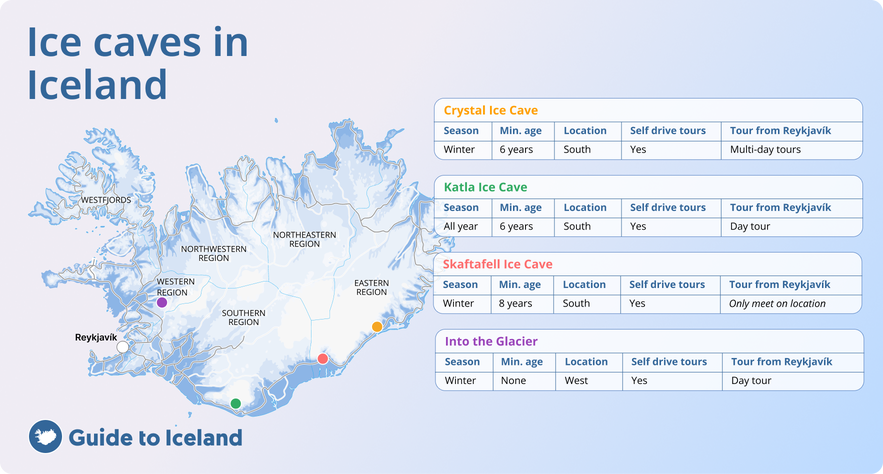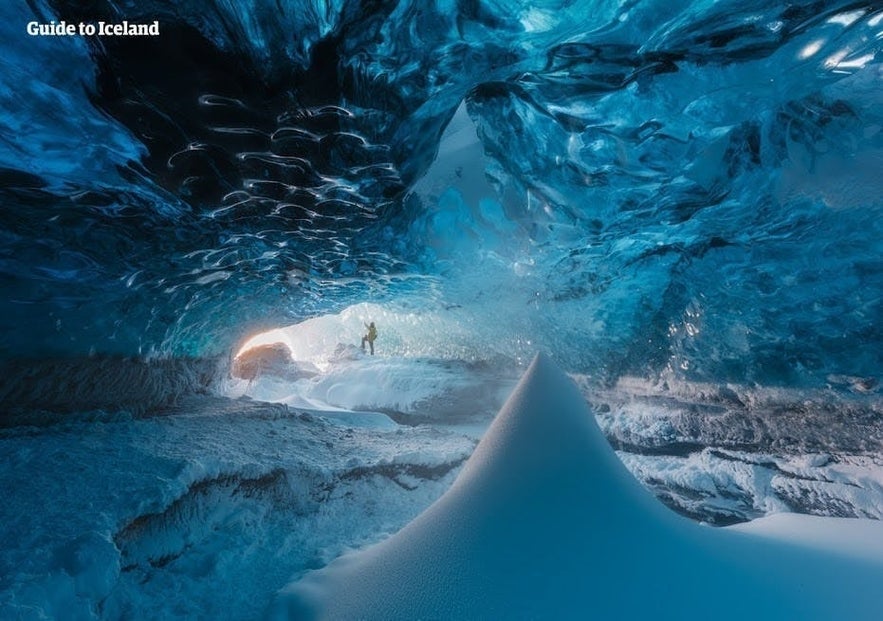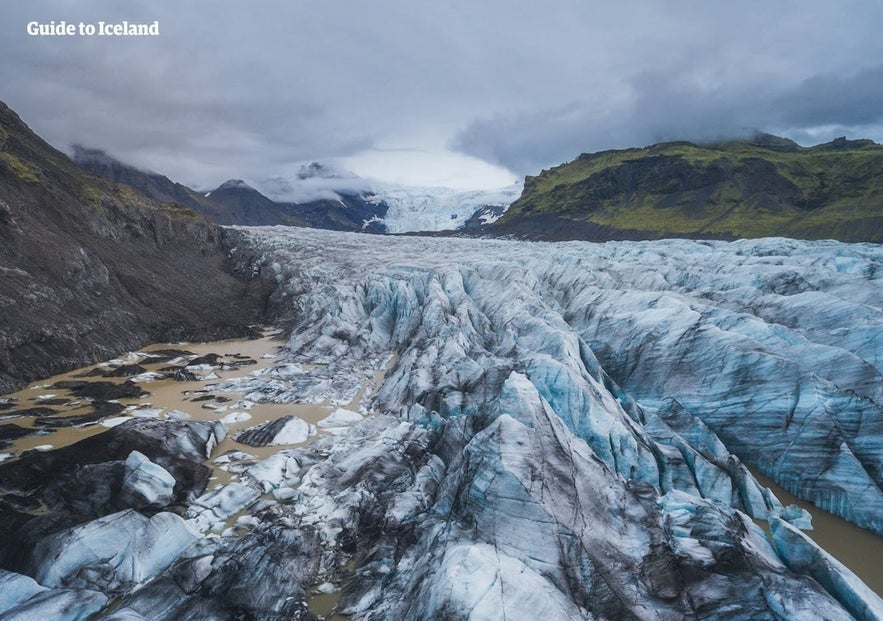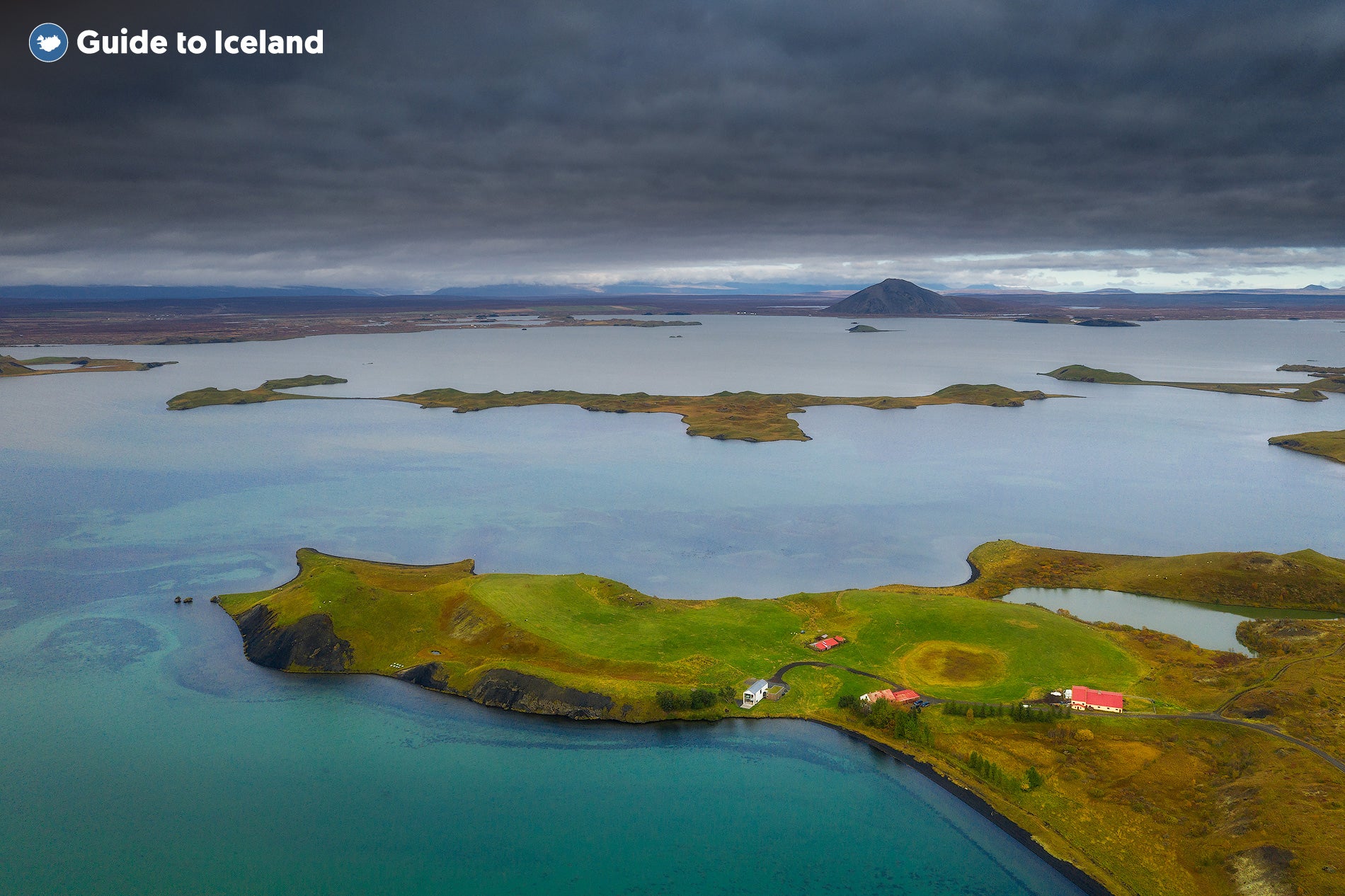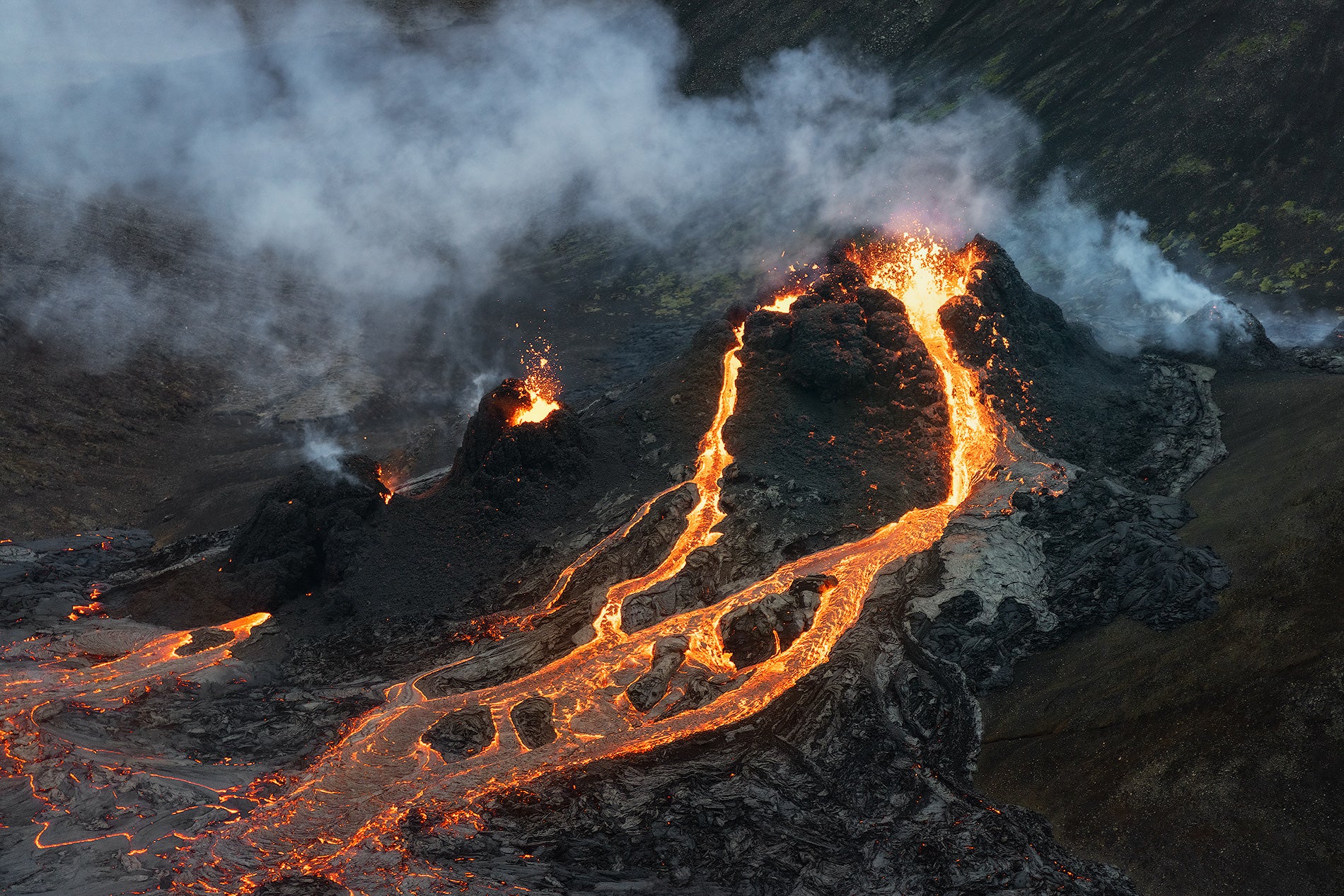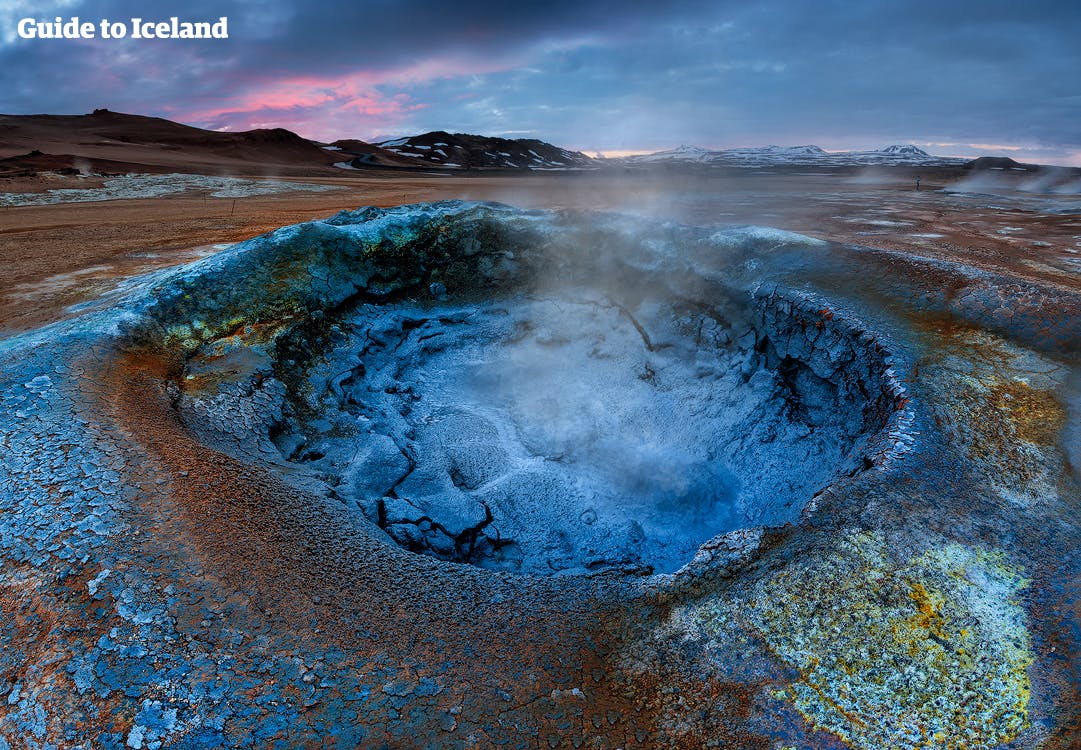Ice caves are some of the most incredible places you can experience in Iceland, attracting travelers from all over the world. Inside, you’ll see brilliant shades of blue ice and shapes carved by centuries of glacial movement. Visiting one is a true highlight of any trip to Iceland.
Most ice caves in Iceland are only accessible in winter, when colder temperatures make the ice stable enough to explore. The 2025–2026 season has already revealed beautiful new ice caves in Vatnajokull Glacier, making this an excellent time to visit Iceland.
Why You Can Trust Our Content
Guide to Iceland is the most trusted travel platform in Iceland, helping millions of visitors each year. All our content is written and reviewed by local experts who are deeply familiar with Iceland. You can count on us for accurate, up-to-date, and trustworthy travel advice.
The only way to visit ice caves in Iceland is on guided ice cave tours with certified glacier experts. The guides are there to ensure your safety and choose the best caves to see based on the weather and glacier conditions.
Ice caves form when water flows through glacier ice and slowly carves open tunnels and chambers. This means that each cave looks different. Walls can appear deep blue, clear, or streaked with volcanic ash depending on the glacier’s history and light.
In this guide, we share where to find the best ice caves in Iceland, when to visit, and how to plan your perfect trip.
10 Quick Facts About Ice Caves in Iceland
-
The Crystal Ice Cave near Jokulsarlon Glacier Lagoon is Iceland’s most famous ice cave.
-
The popular ice caves of Vatnajokull Glacier are located a 5-hour drive from Reykjavik.
-
Myrdalsjokull Glacier and Langjokull Glacier have ice caves that are open year-round.
-
The drive to the ice caves in Myrdalsjokull and Langjokull takes around 3 hours from Reykjavik.
-
Never enter a glacier ice cave without a professional guide—going alone is dangerous.
-
Ice caves change shape every season as the glaciers move and melt.
-
The colors of the ice range from deep blue to white and black, depending on light and ash.
-
Weather conditions greatly impact the accessibility of ice caves.
-
Tours may be canceled for safety reasons, but alternative tours or full refunds are offered.
-
Visiting an ice cave is one of Iceland's most unforgettable winter adventures.
Best Ice Caves in Iceland Winter 2025/2026
Iceland’s glaciers are home to numerous ice caves. But where are they, and what is the best way to visit them? The short answer is that the majority of ice cave tours in Iceland depart from locations along the South Coast. The most popular ice caves to visit can be found in Europe's biggest glacier, Vatnajokull.
Here is a full list of ice caves in Iceland accessible during the 2025-2026 travel season.
1. Crystal Ice Cave in Vatnajokull Glacier
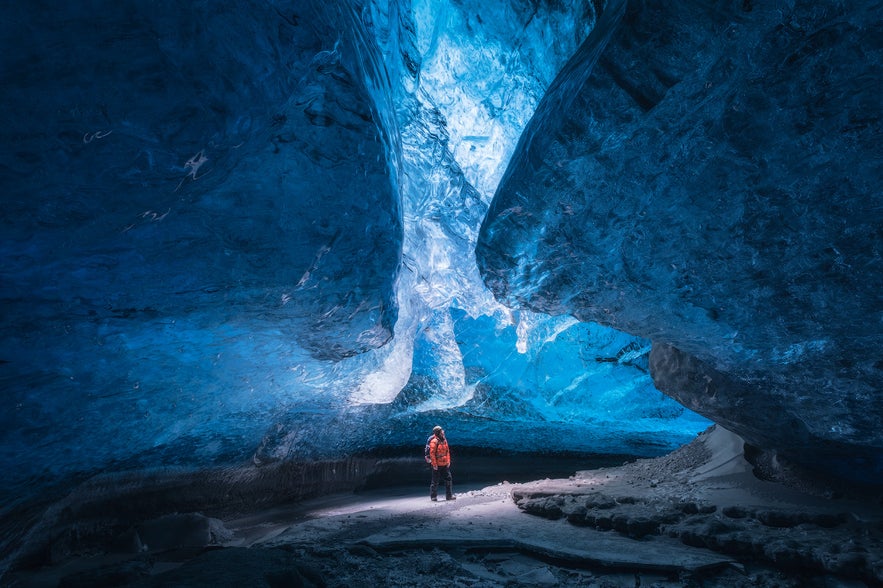 Location: Southeast Iceland, near Jokulsarlon Glacier Lagoon.
Location: Southeast Iceland, near Jokulsarlon Glacier Lagoon.
Details: Known for its vivid blue ice, Crystal Ice Cave is one of the most visited natural ice caves in Iceland. Open from mid-October to March, it’s a must-see for winter travelers coming to Iceland in late 2025 or early 2026. Visiting this remarkable ice cave offers breathtaking views and a close-up look at Iceland’s unique glacial formations.
How To Visit Crystal Ice Cave:
If you don't want to join a guided multi-day tour, the starting point for the 3-hour tour to the ice cave can also be reached by renting a car and staying at hotels near the Glacier Lagoon.
Many winter vacation packages also include ice caving tours. Adding the Crystal Ice Cave to your winter self-drive tour is an easy and smart way to save money on your trip to Iceland.
2. Katla Ice Cave in Myrdalsjokull Glacier
Location: South Iceland, near Vik, the southernmost village in Iceland.
Details: A year-round ice cave beneath the Katla Volcano, featuring unique black ash layers mixed with ice. Its unique formations change frequently due to glacial movement, making each visit a little different. The famous arch collapsed recently, but the ice cave remains majestic, and so does the nearby scenery.
How To Visit Katla Ice Cave:
If you’re driving the South Coast, Katla is one of the easiest ice caves to visit in Iceland. Tours also depart daily from Reykjavik. All tours provide Super Jeep transfers to the glacier.
The drive from Reykjavik to Vik takes about 3 hours, making the ice cave visit easy to do on a day tour or to include on a multi-day South Coast itinerary.
3. Skaftafell Ice Caves in Vatnajokull Glacier
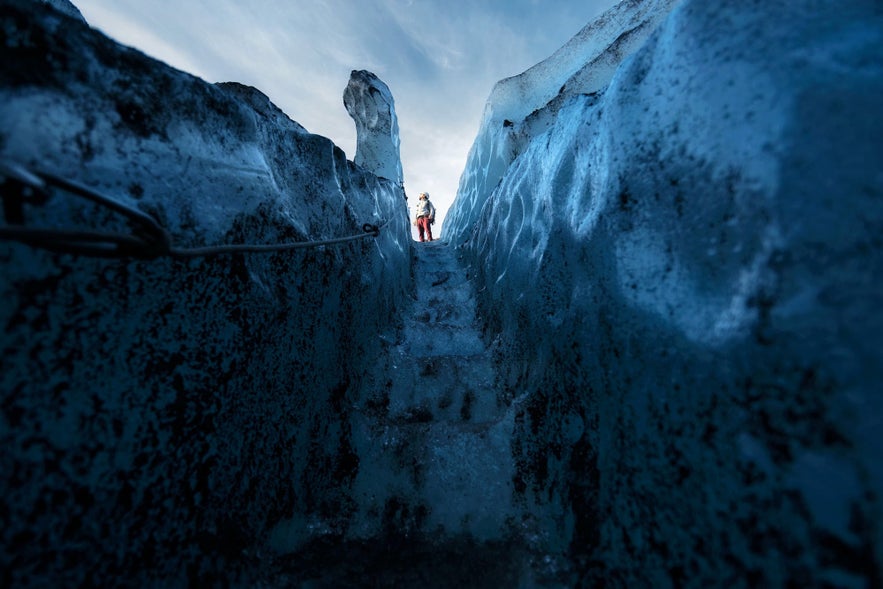 Location: Southeast Iceland near Skaftafell Nature Reserve.
Location: Southeast Iceland near Skaftafell Nature Reserve.
Details: These seasonal ice caves of Skaftafell are typically accessible from November through March. Forming in different areas each year, they are often combined with glacier hiking tours for the ultimate adventure. The ice cave currently visited in Skaftafell is like a canyon with no roof, so if you are claustrophobic, this is the best ice cave to visit in Iceland.
How To Visit Ice Caves in Skaftafell:
Skaftafell is easily accessible for travelers driving the South Coast, located about 4 hours and 20 minutes from Reykjavik and just 1 hour from Jokulsarlon Glacier Lagoon.
All ice cave tours in Skaftafell depart from the visitor center within the Skaftafell Nature Reserve. This area is ideal for travelers who want to experience glacier hiking and prefer more active tours.
4. Ice Caves and Man-Made Ice Tunnels in Langjokull Glacier
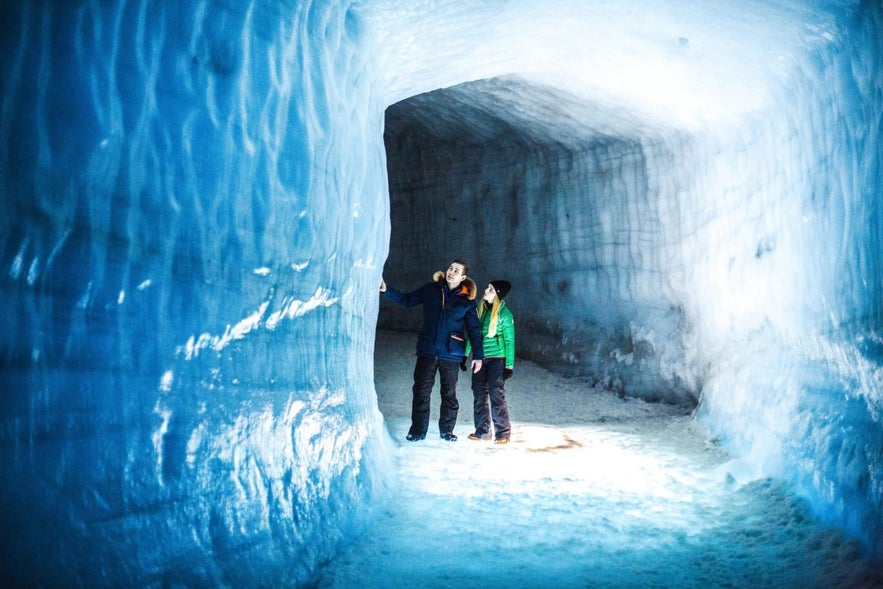 Location: West Iceland, but the starting locations are different for the man-made and natural caves.
Location: West Iceland, but the starting locations are different for the man-made and natural caves.
Details: "Into the Glacier" is a series of man-made ice tunnels carved into Langjokull Glacier, providing a fascinating year-round experience with educational tours on glacial formations. Recent updates include improved lighting and expanded sections for a more immersive experience.
Natural ice caves in Langjokull Glacier are only accessible by snowmobile.
How To Visit Ice Caves in Langjokull Glacier:
The Into the Glacier experience is easy to access, about a 2-hour drive from Reykjavik. Tours depart either from the Langjokull base camp or include round-trip transfers from the capital, making it a convenient year-round activity. The snowmobiling tour to the natural ice caves can easily be added to Golden Circle tours.
5. Ice Cave at Perlan Museum

Location: Reykjavik, the capital city of Iceland.
Details: A man-made ice cave located inside the Perlan Museum offers an educational and immersive experience that’s accessible year-round. Visiting the Wonders of Iceland exhibition is a great option for travelers who want to experience an ice cave in Iceland without venturing onto a glacier.
How To Visit Perlan Museum:
Perlan Museum is located just a 10-minute drive from downtown Reykjavik and is easy to reach by car or public transport.
It’s open year-round, making it ideal for families, winter visitors facing bad weather, or anyone looking to learn more about Iceland’s glaciers before exploring them in nature.
When is the Best Time To Visit Ice Caves in Iceland?
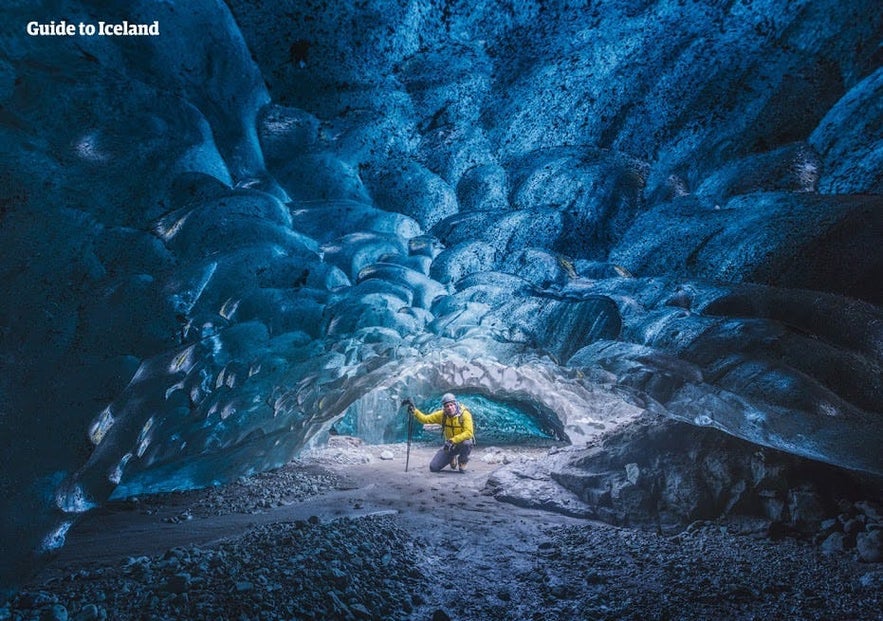
"The absolute best time to visit is between November and March, when the weather has been cold. The consistent freezing temperatures make the ice stronger and the formations more vivid."
Most ice cave tours in Vatnajokull, including those to Crystal Ice Cave, begin in November. This means visiting Iceland in winter allows you the best chances to explore these glacial wonders safely.
While winter is the main season for natural ice caves, you can also explore some year-round options. These include the Katla Ice Cave on the South Coast and the man-made ice tunnels in Langjokull Glacier. While technically not an ice cave, the unique Lofthellir Cave in North Iceland is also accessible year-round.
The weather in Iceland plays a big role in ice cave accessibility, and tours may be canceled if conditions are unsafe. But rest assured, if your tour is canceled, you will be offered to visit on a different day or receive a full refund.
Booking your tour early in your trip is a smart way to increase your chances of visiting, as it gives you flexibility to reschedule if needed.
How To Plan a Trip To See Ice Caves in Iceland
 Exploring ice caves and snow-covered landscapes are among the top winter activities in Iceland. Booking a trip to experience this, and everything else Icelandic winter has to offer, requires less effort than most travelers think.
Exploring ice caves and snow-covered landscapes are among the top winter activities in Iceland. Booking a trip to experience this, and everything else Icelandic winter has to offer, requires less effort than most travelers think.
Whether you prefer a fully arranged vacation or want to plan everything yourself, there’s an option for you.
Complete Winter Vacations in Iceland
If you’d like everything organized in advance, choose one of our complete travel packages to Iceland. These include customizable accommodation, transport, guided tours, and activities — all carefully planned around daylight hours and Iceland's weather. The majority of winter packages also offer opportunities to visit ice caves.
-
Winter self-drive tours – Choose this option if you want the freedom and flexibility to drive yourself while everything from accommodation to activities is pre-booked.
-
Winter vacation packages – Ideal if you want a complete itinerary that combines transfers, tours, and accommodations for a seamless winter trip to Iceland.
Planning Your Own Winter Trip in Iceland
If you’d rather travel independently, you can easily plan your own trip to Iceland. Start by arranging your essentials, then add activities like ice cave tours for an unforgettable highlight.
-
Arrange your rental car to explore Iceland at your own pace and access top attractions.
-
Book accommodations ranging from cozy countryside stays to modern hotels in Reykjavik.
-
Add day tours, such as glacier tours and northern lights excursions, for the ultimate trip.
FAQs About Ice Caves in Iceland
This section answers common questions about Iceland’s ice caves, providing insights into these mesmerizing natural wonders.
1. Do you have to hike to get to ice caves in Iceland?
It depends on the cave. Some ice caves require short glacier hikes, while others are reached by Super Jeep, snowmobile, or glacier trucks.
-
Crystal Ice Cave (Vatnajokull Glacier): Super Jeep, followed by a short, easy glacier hike.
-
Skaftafell Ice Cave (Vatnajokull Glacier): Moderate hike from Skaftafell Visitor Center.
-
Katla Ice Cave (Myrdalsjokull Glacier): Super Jeep from Vik with a minimal, easy hike.
-
Into the Glacier Ice Tunnels (Langjokull Glacier): Snowmobile or glacier truck, no hiking.
-
Perlan Museum Ice Cave (Reykjavik): Indoor experience with full accessibility.
Every tour includes the proper safety equipment and is led by certified glacier guides who ensure safe access to the caves.
2. Are ice caves in Iceland safe to visit?
Yes, when visited with certified guides, ice caves in Iceland are generally very safe. Tours are carefully planned around weather and glacier conditions, and participants are provided with helmets, crampons, and other safety gear. National park authorities and local operators have introduced strict daily safety inspections to ensure all ice cave tours take place only in stable and secure conditions.
3. Can I visit an ice cave in Iceland by myself?
No, ice caves can only be visited with certified glacier guides. Entering one alone is extremely dangerous because glaciers are full of hidden crevasses, and the ice can shift or collapse without warning. Even the roads leading to the caves can be unstable due to melting “dead ice.” Always join a guided ice cave tour, where experts provide safety gear and ensure conditions are secure.
4. Can children visit ice caves in Iceland?
Yes, many tours are family-friendly, but age restrictions vary. Generally, children aged 6 or older can participate.
5. Can you visit an ice cave in Iceland during the summer?
Yes, some options are available year-round, such as the Katla Ice Cave tour, the Langjokull "Into the Glacier" Ice Tunnels, and the Perlan Museum in Reykjavik. However, this Crystal Ice Cave tour and other ice caves in Vatnajokull are typically only accessible in winter.
6. Can I cancel my ice cave tour?
Yes, you can cancel any ice cave tour up to 24 hours before departure and receive a full refund. Please note that you have to inform us at least 24 hours before your tour starts so we can ensure your refund. As soon as you confirm that you wish to cancel, we will initiate the refund, which will arrive in your bank account within a few days.
7. What happens if my ice cave tour gets canceled because of bad weather?
If your ice cave tour is canceled due to bad weather, you’ll be presented with several options. You can choose an alternative activity for the day, reschedule your ice cave tour at the earliest opportunity, or cancel your booking for a full refund. The choice is entirely yours.
8. What happened to the Askur Ice Cave in Myrdalsjokull Glacier?
The Askur Ice Cave in Myrdalsjokull Glacier is currently closed due to damage caused by flooding and glacial movement. Heavy meltwater flow reshaped the cave’s structure, making it unsafe for tours.
As with all natural glacier caves in Iceland, conditions can change rapidly from one season to the next, and safety inspections are required before tours can reopen. As of November 2025, local guides continue to monitor the area, and Askur may reopen in a future season if the ice stabilizes and safe access can be restored.
9. Where is the natural ice cave closest to Reykjavik?
The closest natural ice cave to Reykjavik is Katla Ice Cave. Located in Myrdalsjokull Glacier in South Iceland, it lies just about 206 miles (331 kilometers) from Iceland’s capital. The drive from Reykjavik takes roughly 3.5 hours, making it one of the most convenient ice cave adventures for visitors who don’t want to travel too far from the city.
10. What are ice caves, and how are they formed?
Ice caves are natural formations within glaciers, created by meltwater, wind, and temperature fluctuations. Water from melting ice carves tunnels and chambers, while freezing conditions preserve these stunning formations, often showcasing vibrant blue tones.
11. What's the difference between ice caves and glacier caves?
The terms "ice caves" and "glacier caves" are often used interchangeably, but they technically refer to different formations. Ice caves are any caves that contain ice, but they don't have to be made entirely of ice. They are often found in rock formations where ice persists throughout the year. Glacier caves are specific to glaciers and are tunnels or chambers formed entirely within the ice.
12. What color are ice caves?
Depending on conditions, ice caves may look white, blue, turquoise, grey, or even black when volcanic ash, snow, or shadows mix with the ice. These brilliant colors make Iceland’s ice caves one of the most captivating natural sights in the world.
13. Why are ice caves blue?
Ice caves appear blue because of the unique properties of glacial ice. Over centuries, the ice becomes extremely dense, squeezing out air bubbles and allowing it to absorb every color of light except blue, so that’s the color we see.
14. Are all ice caves blue in Iceland?
Not all ice caves in Iceland are blue. While many glacier caves glow with vivid blue tones caused by dense, bubble-free ice that absorbs every color of light except blue, their appearance can vary widely. The color of the ice depends on factors such as air bubbles, light conditions, and the materials trapped within the glacier.
Some caves appear white or turquoise when snow and air scatter light, while others look grey or black due to volcanic ash and sediment. Because many of Iceland’s glaciers sit on volcanic ground, darker layers are common, giving each ice cave its own unique look.
15. How is global warming affecting Iceland’s ice caves?
Rising global temperatures are changing Iceland’s glaciers faster than ever before, and this directly affects the formation and stability of ice caves. Warmer winters and shorter periods of freezing make it harder for natural ice caves to form and stay safe for long. Some caves now appear later in the season or melt earlier than they used to.
Glacier guides and national park authorities closely monitor these changes, adjusting tour routes and operating seasons each year to keep travelers safe. While global warming poses challenges, it also highlights the importance of seeing these extraordinary formations responsibly.

